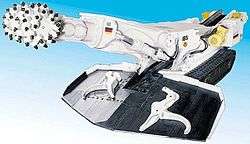Roadheader
A roadheader, also called a boom-type roadheader, road header machine, road header or just header machine, is a piece of excavating equipment consisting of a boom-mounted cutting head, a loading device usually involving a conveyor, and a crawler travelling track to move the entire machine forward into the rock face.[1]

The cutting head can be a general purpose rotating drum mounted in line or perpendicular to the boom, or can be special function heads such as jack-hammer like spikes, compression fracture micro-wheel heads like those on larger tunnel boring machines, a slicer head like a gigantic chain saw for dicing up rock, or simple jaw-like buckets of traditional excavators.[2]
History
The first roadheader patent was applied for by Dr. Z. Ajtay in Hungary, in 1949.[1] It was invented as a remote operated miner for exploitation of small seam, close walled deposits, typically in wet conditions.
Types
Cutting Heads:
- Transverse - rotates parallel to the cutter boom axis
- Longitudinal - rotates perpendicular to boom axis
Uses
Roadheaders were initially utilized in coal mining applications. The first use of a roadheader in a civil engineering project was the construction of the Melbourne Underground Rail Loop in the 1970s, where the machines enabled around 80% of excavation to be performed mechanically.[3]
They are now used in a broad range of applications including but not limited to tunneling both for mining and municipal government projects, building wine caves, and building cave homes such as those found in the Coober Pedy area of Australia.
On February 21, 2014, Waller Street, just south of Laurier Avenue collapsed into an 8m-wide and 12m-deep sink-hole where a roadheader was excavating the eastern entrance to Ottawa's LRT O-Train tunnel.[4] A similar incident occurred in June 2016, when a sink-hole opened up in Rideau Street during further construction of the tunnel, and filled with water up to a depth of three metres. The CBC reported that one of Rideau Transit Group’s 135-tonne roadheaders was in a part of the tunnel where the flooding was the deepest. Three roadheaders were used in the construction of the O-Train.[5]
Projects utilizing roadheaders
- Boston's Big Dig[6]
- Ground Zero Cleanup[7]
- Addison Airport Tunnel Project[8]
- Fourth bore of Caldecott Tunnel[9]
- Malmö City Tunnel
- Confederation Line, Ottawa
References
- Dr. Helmut Schneider (September 1988). "Criteria for Selecting a Boom-Type Roadheader". Mining Magazine. The Mining Journal, Ltd. p. 183.
- "Tunnel Virtual Team - Questions and Answers from Ask the Expert". US Department of Transportation Federal Highway Administration. 2006-08-01. Retrieved 2006-09-15.
- "Melbourne Underground Rail Loop Handbook" (PDF). City Loop history. Department of Transport. p. 5. Archived from the original (PDF) on 28 June 2009.
- "Road collapse leaves 8-metre wide sinkhole at tunnelling site". CBC News. 2014-02-21. Retrieved 2018-12-04.
- Chianello, Joanne (2016-06-18). "City to investigate why shutting off water took 2 hours after sinkhole occurred". CBC News. Retrieved 2018-12-04.
- "MTA - Tunnel Jacking". Massachusetts Turnpike Authority. Archived from the original on 2006-09-02. Retrieved 2006-09-15.
- "Reconstruction : Port Authority on Schedule with Restoration of PATH Service". New York Construction. McGraw_Hill CONSTRUCTION. July 2003. Retrieved 2006-09-15.
- "American Underground-Construction Association's Featured Project". American Underground Construction Association. September 1998. Archived from the original on 2013-04-14. Retrieved 2006-09-15.
- "Caldecott fourth bore big dig starts today in Orinda". Contra Costa Times. 2010-08-09. Retrieved 2010-08-09.
External links
| Wikimedia Commons has media related to Roadheaders. |